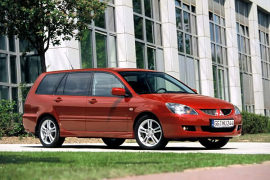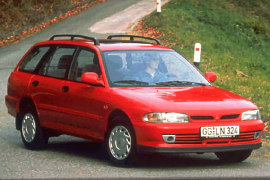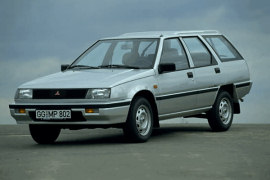MITSUBISHI Lancer Combi Models/Series Timeline, Specifications & Photos
First production year: 1989
Engines: Gasoline, Diesel
Body style: Wagon (station wagon, estate, combi, touring)
In 2003 Mitsubishi introduced a facelifted version for the seventh Lancer, and its station wagon version received the updated package as well.
While the Lancer mainly was known for its Evolution lineup, the Japanese carmaker offered the compact vehicle in a more family-friendly version: the station wagon. Like its three-box sedan sibling, it was also available with the turbocharged all-wheel-drive system for specific markets. Still, mostly it was sold as an economical, front-wheel-drive vehicle.
The new look showed curved triangular headlights and a smiling grille split in half by a vertical slat that featured the chromed Mitsubishi badge. Its front bumper sported a wide and slim grille flanked on the sides by side-scoops for the fog lights. The Japanese carmaker built the vehicle with similar shapes up to the B-pillar, but it featured a roof extended over the trunk area, with a set of windows behind the rear doors. At the back, the tailgate was flat and vertical to maximize the interior space.
Inside, the carmaker installed a curved dashboard with a raised area for the instrument cluster. Its white dials with red needles resembled those from a sports car, even though it was just an economic station wagon. The center stack featured the CD radio and the climate control dials. At the back, Mitsubishi installed a 60/40 split-folding seatback, which expanded the trunk size from 400 liters (14.1 cu-ft) to 1,200 liters (42.4 cu-ft).
Under the hood, the carmaker installed a choice of three gasoline engines ranging between 96 hp and 135 hp. All versions were paired with a five-speed manual and sent the power to the front wheels only. The carmaker offered the Lancer Wagon in Evolution version, which pumped out up to 210 hp sent in all corners for selected markets.
Mitsubishi built the Lancer as a Colt version and evolved into a distinct vehicle range that included a coupe and a station wagon.
By 1991, the Lancer was already a known name on several markets. The Japanese carmaker introduced the station wagon in 1992, using the same platform as the Colt, but with entirely different bodywork. It wasn't that supermini hatchback anymore but evolved into a family car.
With its narrow front end and the horizontal headlights, the Lancer Wagon/Combi featured a thin grille that sported the Mitsubishi badge in the middle and a plastic, wrapped-around bumper. On the apron, the carmaker placed a taller and broader grille to enhance the engine cooling. As a station wagon, the car featured a straight, extended roof. Its raked-forward tailgate diminished the car's trunk but enhanced its look.
Inside, the '92 Lancer was the first to show rounded shapes and curved lines. Its predecessor was more on the wedged style. Its instrument panel featured a large speedometer in the middle and a tachometer on its left side. On the right dial, the carmaker installed the coolant temperature and the fuel level gauges. The center stack hosted the ventilation controls and the tape player. In the cabin, it was room for up to five adults, with a split-folding rear bench. With the seats up, the trunk could host up to 470 liters (16.6 cu-ft) of luggage, while with the rear seats folded, it increased to 1,399 liters (49.4 cu-ft).
Mitsubishi installed a choice of three engines under the Lancer Wagon's hood, depending on the market, and paired them to a five-speed manual.
Based on the same platform as the Colt/Mirage, the second generation of the Lancer was also offered as a station wagon in 1985 and received an upgrade in 1989.
Some might ask what was different with this facelifted version since it featured the same design language as the 1983 Mirage. And yet, besides the obviously bigger trunk, the second generation of the Lancer also got some technical upgrades, which paved the way for future high-performance models.
Clearly, the car's exterior was still governed by the old, wedged shape imagined by Mitsubishi in the late '70s – early '80s. Still, its rectangular headlights were better incorporated into the front fascia. In addition, the grille received a new look with a thicker upper slat and three thinner ones underneath that. While the profile revealed a similar sight as the Lancer sedan, it looked different behind the C-pillars. The long roof version got a slightly taller section that was extended up until the tailgate. At the back, the corner-mounted taillights were also squared and flanked the trunk's opening.
Inside, the dashboard featured a new instrument cluster, reshaped, so it didn't look like a square box. Its upper corners were shaved and tilted inwards, offering a similar design as other cars from that era. Like its predecessor, it featured slim, low-mounted seats for the front passengers. For the rear ones, though, unlike the sedan, it featured a folding bench fit for three. Thus, the trunk could have been expanded inside the cabin to load longer items.
Under the hood, the automaker was not that generous, offering just a few engines. Yet, for specific markets, the Lancer Combi was available with an all-wheel drive system. That was an intelligent option, which allowed Mitsubishi to enter into the rally world arena with the Lancer.


